of Herring Island Park

Australian Native Flowers
of Herring Island Park

In addition to the plants listed on the "plants of the island" page (all of which were used by the Kooris and early settlers for food or utilitarian purposes), the flowering plants listed on this page have been planted on Herring Island as part of the Friends revegetation program.
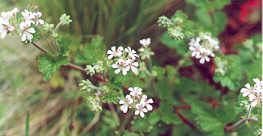 Austral Stork's Bill (Pelargonium australe) - Low shrubby plant preferring moist soil in full sun. Flowers October to February. |
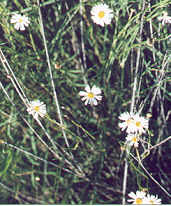 Basalt Daisy (Brachyscome basaltica) - A small white daisy which grows on moist to wet soil. Flowers September to January. |
Black Sheoak - (Allocasuarina littoralis) - Tree to 8 metres tall. Flowers from March to June.  Male flowers are borne in fluffy brown spikes.  Female flowers are a small crimson hairy tuft. Sheoaks are sometimes mistaken for pine trees; what looks like pine needles are actually leaf stems where the leaves have evolved to microscopic size. |
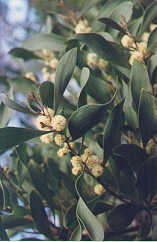 Blackwood (Acacia melanoxylon) - Medium size tree with dense foliage. Flowers July to October. Prefers a sheltered position in moist soil. |
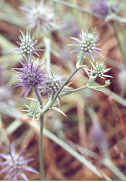 Blue Devil (Eryngium ovinum) - A very prickly plant flowering from December to January. Needs good drainage. Dies back in autumn and re-shoots in winter. |
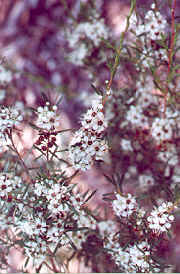 Burgan (Kunzea ericoides) - A large shrub or small tree which rapidly spreads itself by seed, forming a dense thicket. A favourite nesting site for ringtail possums. Prefers an open position in moist soil, flowering from November to February. |
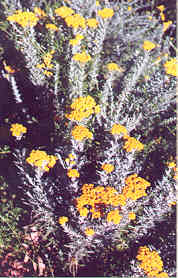 Clustered Everlasting (Chrysocephalum semipapposum) - A tall daisy which grows in dry soil, in full sun, flowering September to January. |
 Common Billy Buttons (Craspedia variabilis) - Grows in moist grassland. Flowers September to March. |
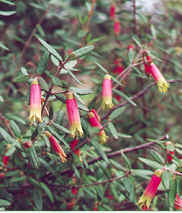 Common Correa (Correa reflexa) - Variable from open to dense shrub. Flowers from March to September, but also sporadic at other times. Attractive to nectar-feeding birds. |
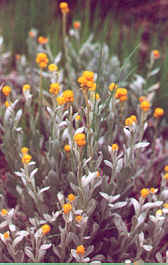 Common Everlasting (Chrysocephalum apiculatum) - Spreads out to form a low mat. Flowers September to January. |
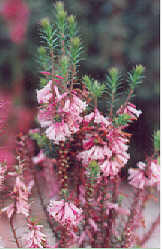 Common Heath (Epacris impressa) - Victoria's floral emblem. A low shrub with pink or white flowers from July to September. Prefers a sheltered position in moist well-drained soil. |
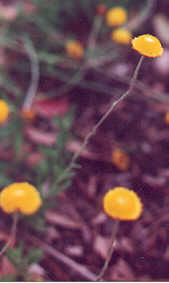 Curling Everlasting (Helichrysum scorpioides) - A small spreading plant preferring a dry, sheltered position, flowering October to March. |
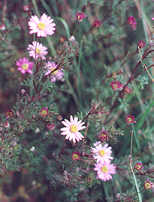 Cut Leaf Daisy (Brachyscome multifida) - A pale purple daisy which grows on moist soil. Fine lacy leaves on suckering stems. Flowers September to February. |
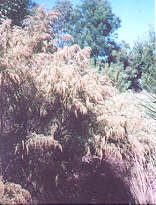 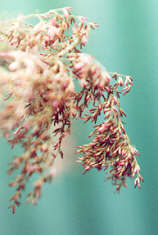 Drooping Cassinia or Chinese Scrub (Cassinia arcuata) - A small shrub with tiny brown cinnamon scented flowers from December to June. The name "Chinese Scrub" comes from the time of the gold rush when it grew on disturbed soil around old mines which were often re-worked by Chinese diggers. |
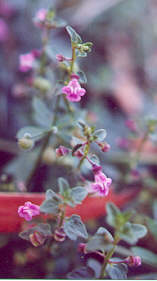 Dwarf Skull Cap (Scutellaria humilis) - Groundcover with suckering stems. Prefers a sunny position in moist soil. Flowers October to February. |
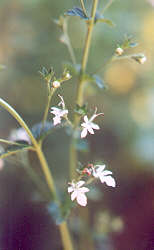 Forest Germander (Teucrium corymbosum) - A small shrub which grows in moist soil in semi-shade. Flowers from December to January. |
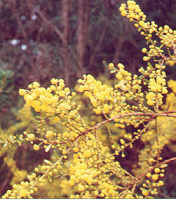 Gold Dust Wattle (Acacia acicacea) - Small shrub, flowering July to November. Grows in dry soil, preferring semi-shade. |
 Golden Spray (Viminaria juncea) - Tall shrub with flowers October to February. Prefers an open position in moist to wet soil. |
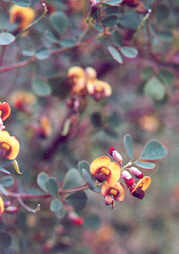 Golden Tip (Goodia lotifolia) - A medium sized suckering shrub with flowers August to October. Prefers a moist, well-drained position. |
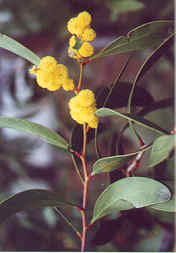 Golden Wattle (Acacia pycnantha) - Australia's Floral Emblem. A large shrub or small tree with strongly perfumed flowers from August to October. A gland at the base of the leaf-stem provides food for nectar-eating birds. Grows in dry soil and is very drought tolerant. |
 Grass-leaf Trigger Plant (Stylidium graminifolium) - Grows in a protected position in moist, well-drained soil. Flower stems rise from a small grass-like tuft from September to December. Visiting insects set off a trigger mechanism which deposits pollen on their backs. |
 Greenhood Orchid (Pterastylis curta) - A ground dwelling orchid. Flowers in late winter/early spring, dying down to a tuber in summer. Tubers were eaten by the Wurundjeri people. |
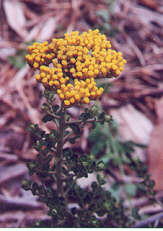 Grey Everlasting (Ozothamnus obcordatus) - A small shrub with dark grey/green foliage. Grows in dry open forest. Flowers Spring and Summer. | |
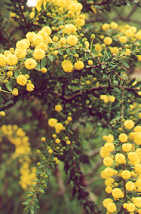 Hedge Wattle(Acacia paradoxa) - Medium-size shrub. Flowers July to December. Prefers a moist, sheltered position. Its prickly foliage provides refuge for small birds. |
 Hop Bitter-Pea (Daviesia latifolia) - A small shrub which grows in moist soil, in semi-shade, flowering September to December. |
 Hop Goodenia - (Goodenia ovata) - A low shrub which grows in moist, well-sheltered position, flowering August to February. Propagating Goodenias - comparing 'Clonex' Propagating Gel with Honey and no treatment |
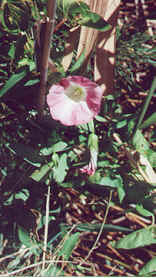 a hybrid of Large Bindweed and Greater Bindweed (Calystegia sepium) or (Calystegia silvatica) - Large Bindweed is a local native plant. Greater bindweed is a native of southern Europe which has been introduced as a garden plant. The imported plant is now much more common than the local plant, which is threatened with absorption into the larger gene-pool. |
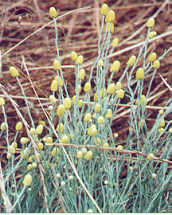 Lemon Beauty Heads (Calocephalus citreus) - Flowers October to March. Dies down after flowering; re-shoots mid winter; needs well drained soil. |
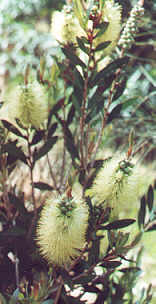 Lemon Bottle-Brush (Callistemon paludosa) - Medium shrub. Grows in moist to wet soil. Flowers October to November. |
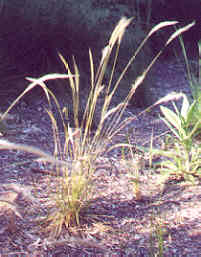 Long Haired Plume Grass (Dichelachne crinita) - Small tussock grass which grows in moist, well-drained soil, flowering October to April. |
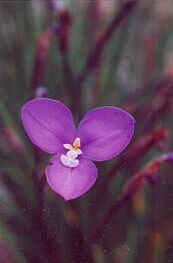 Long Purple Flag (Patersonia occidentalis) - Flower stems arise from a tussock of strap-like leaves from October to January. Flowers last one day only. Prefers a sheltered site in moist soil. |
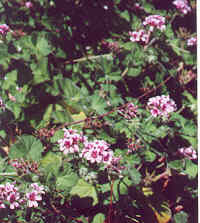 Magenta Stork's Bill (Pelargonium rodneyanum) - A small low-growing plant which grows in an open, dry position, flowering October to February. |
 Milk Maids (Burchardia umbellata) - Small honey scented lily. Grows in well-drained moist soil. Flowers August to January. Tubers are edible and tasty. |
 Native Violet (Viola hederacea) - Creeping groundcover, flowers most of the year, profusely from August to November. Prefers moist soil in semi-shade. |
 Pale Everlasting (Helichrysum rutidolepis) - A suckering plant with everlasting flowers. Flowers October to March. |
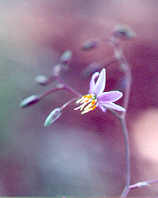 Pale Flax Lily (Dianella longifolia) - Flowerhead up to 1.2 metres tall. Flowers November to January, preferring a sheltered, semi-shaded position in moist, well drained soil. |
 Pale Vanilla Lily (Arthropodium milleflorum)> - A small, vanilla scented plant which flowers from September to March. Prefers a sheltered position in moist, well-drained soil. |
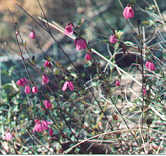 Pink Bells (Tetratheca ciliata) - A small shrub flowering July to December. Prefers a dry sheltered position in semi-shade. |
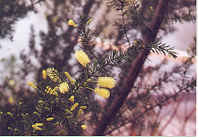 Prickly Moses (Acacia verticillata) - A large prickly shrub - a good refuge for small birds. Flowers from September to November. |
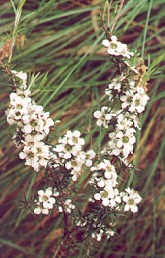 Prickly Tea-Tree (Leptospermum continentale) - Tall shrub with prickly leaves. Grows in a moist to wet position. Flowers October to November. |
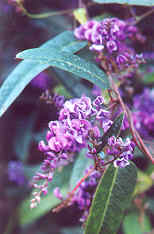 Purple Coral Pea (Hardenbergia violacea) - A climber to 2 metres, preferring an open position in dry, well-drained, heavy soil. Flowers July to November. |
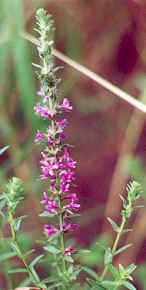 Purple Loosestrife (Lythrum salicaria) - Semi-aquatic plant which grows on river banks. Flowers from November to March. |
 Pussy Tails - (Ptilotis spathulatus) - A small prostrate plant which dies off in summer after flowering between September and January. |
 River Bottle-Brush (Callistemon sieberi) - A willowy shrub, 2 - 4 metres tall with creamy white flowers, sometimes tinted with pink. Prefers damp soil. Flowers December to March. |
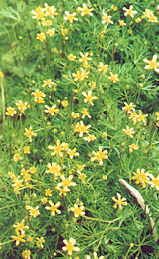 River Buttercup (Rununculus inundatus) - Semi-aquatic suckering plant. Flowers November to January. |
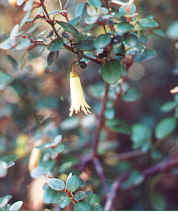 Rock Correa (Correa glabra) - Bushy shrub. Flowers from April to August, but also sporadic at other times. Attractive to nectar-feeding birds. |
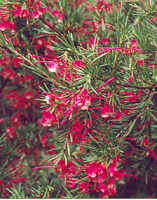 Rosemary Grevillia (Grevillia rosmarinifolia) - Small shrub, flowering August to November. Prickly foliage provides shelter for small birds, while the flowers provide food for nectar eating birds. Prefers an open dry position. |
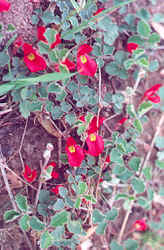 Running Postman (Kennedia prostrata) - Clover like groundcover with flowers September to December. Prefers dry soil in semi-shade. |
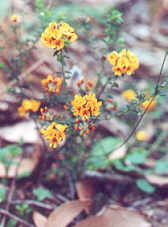 Showy Bossiaea (Bossiaea cinerea) - A small shrub growing in sandy soil, flowering September to October . |
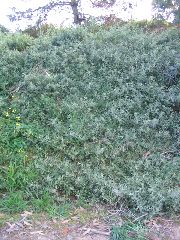 Mealy salt bush (Rhagodia parabolica) - Dense sprawling shrub growing in sandy soil, with inconspicuous whitish flowers December to April . |
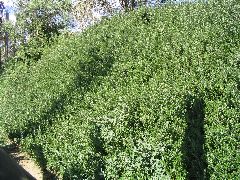 Seaberry Saltbush (Rhagodia candolleana) - A small shrub growing in sandy soil, flowering September to October . |
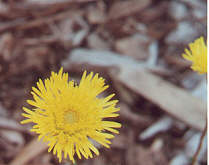 Showy Podolepis (Podolepis jaceoides) - Herb to 20cm tall. Flowers October to December. Grows in grassy woodland. |
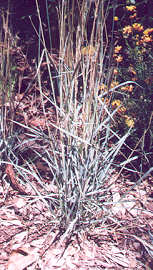 Silky Blue Grass (Dichantheum sericeum ) - 30 cm tussock with flowerheads up to 80 cm tall. Prefers a moist well drained soil in full sun. Flowers September to February. Seeds are eaten by small birds. |
 Silky Hakea (Hakea sericea) - Medium sized shrub with prickly foliage and white or pink flowers from July to September. Prefers a sunny position in well-drained soil. Small birds use the prickly foliage as a refuge. |
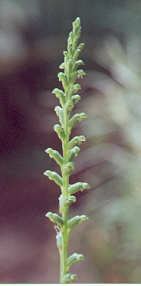 Slender Onion Orchid (Microtis parvifolia) - Terrestial orchid, with onion like leaves and many tiny green flowers growing on a 40 cm tall spike. Grows in moist, grassy areas. Unlike most native orchids, this one is quite easy to cultivate. |
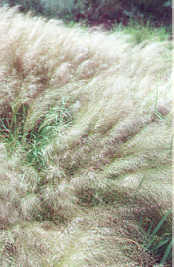 Slender Spear Grass (Stipa scabra) - Grows in a dry, well-drained soil. Silky flower heads from September to November. |
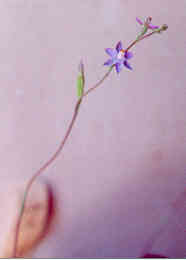 Slender Sun-Orchid (Thelymitra pauciflora) - This plant was recorded growing wild on Herring Island in the 1991 flora survey, but has not been seen on the island since then. Melbourne's bushland once had many species of orchids growing abundantly. Unfortunately these orchids are vulnerable to environmental disturbance and are becoming increasingly rare. Most of our native orchids are difficult to cultivate and are more difficult to re-introduce to the wild. |
 Small-Leafed Clematis (Clematis microphylla) - A climber to 5 metres, preferring an open position in dry, well-drained, heavy soil. Flowers July to October with feathery seed heads in November and December. |
 Small-leafed Eutaxia (Eutaxia microphylla) - A small shrub grows in dry, well-drained soil. Yellow and red "Egg & Bacon" pea shaped flowers August to December. |
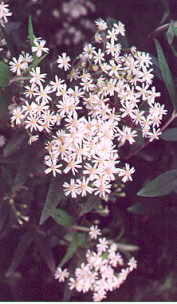 Snowy Daisy Bush (Olearia lirata) - A tall shrub which grows in a moist sheltered position. Flowers September to December. |
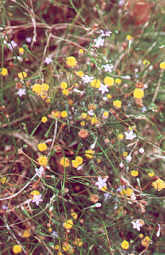 Sprawling Bluebell - (Wahlenbergia gracalis) and Wiry Buttons (Leptorrhyncos tenufolius) - Both plants have small flowers on long slender stems and grow in moist soil. Wiry Buttons flowers from September to January. Sprawling Bluebell flowers from September to February. |
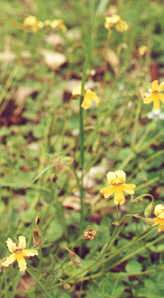 Spur Velleia (Velleia paradoxa) - A small plant grows in a moist, well-drained soil, flowering October to November. |
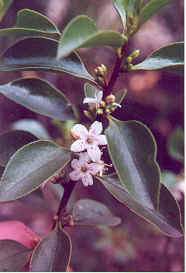 Sticky Boobialla (Myoporum viscosum) - Medium-size shrub with sticky leaves. Flowers August to November. Prefers an open position in well-drained soil. |
 Sticky Everlasting (Bracteantha viscosa)- A biennial multi-stemmed plant. The flowers have a papery texture. It prefers an open position in dry soil and flowers August to April. |
 Sweet Bursaria (Bursaria spinosa) - Medium-size thorny shrub. Flowers November to February. Prefers a well drained soil. Attracts insects and insect eating birds. |
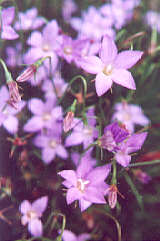 Tall Bluebell (Wahlenbergia stricta) - Flowers on long slender stems from August to January. Grows in dry, well drained soil. |
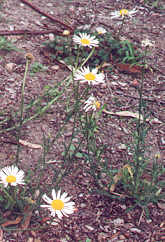 Tall Daisy (Brachyscome diversifolia) - A small plant which grows in dry, well-drained soil. Flowers October to February. |
 Tree Everlasting (Ozothamnus ferrugineus) - A large shrub which grows in moist soil in an open position. Flowers from November to February. |
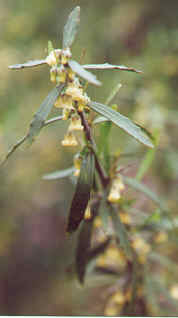 Tree Violet (Melicytus dentatus = Hymenanthera dentata) - A thorny shrub 2 metres tall, distantly related to the garden violet with tiny, intensely perfumed flowers between September and December. Provides shelter for small birds which also eat the berries. Grows in moist, well drained soil. |
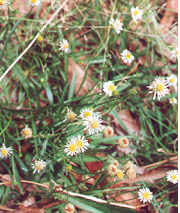 Tufted Burr Daisy (Calotis scapigera) - Groundcover which grows in moist, sheltered position. Flowers from October to March. |
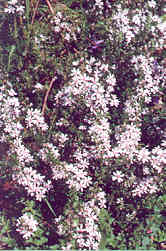 Twiggy Daisy bush - (Olearia ramulosa) - A small plant which grows in a dry position, sun or shade. Flowering from September to May. |
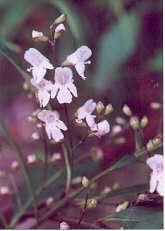 Victorian Christmas Bush (Prostanthera lasianthos) - A tall shrub which grows in a moist sheltered position. It gets its name from the profuse flowers which come out around Christmas time. Also called the "Mint Bush" because of the minty aroma of its leaves. |
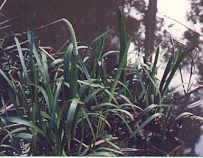 Water Ribbons (Triglochin procera) - Grows in shallow water. The Wurundjeri people gathered the sweet underground tubers which were eaten raw or roasted. |
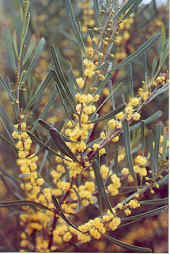 Wirilda or Swamp wattle - (Acacia retinoides) - A tall shrub or small tree, prefering poorly drained, wet winter/dry summer soil. Flowers December to January. |
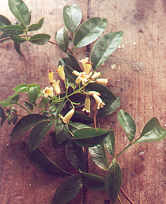 Wonga Vine (Pandorea pandorana) - A robust climber which grows in moist forest. Flowers from September to January. |
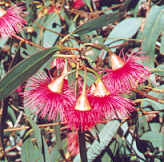 Yellow Gum (Eucalyptus leucoxylon) - Medium size tree, with pink or creamy yellow flowers from July to September. The flowers provide food for nectar eating birds. |
 Yellow Hakea - (Hakea nodosa) - A medium to large shrub prefering damp soil. Dense needle like leaves provides shelter for small birds. Flowers attract nectar-feeding birds. |
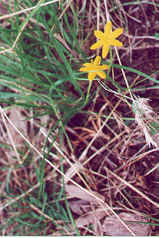 Yellow Rush Lily (Tricoryne eliator) - A small tuft of rush-like leaves. Grows in moist, well-drained soil in full sun. Flowers from September to March. |
Further reading:
The Mornington Peninsula - A Field Guide to the Flora, Fauna and Walking Tracks ISBN 0.7316.8160.6: Southern Peninsula Tree Preservation Sociey.
Plants of Melbourne's Western Plains - Society for Growing Australian Plants, Keilor Plains Group.
Plants of the Merri Merri - Merri Creek Management Committee
VIEW THIS SITE WITH A MENU BAR
About Herring Island |
Getting to and What's on |
Island Map |
Artworks |
Plants |
Flowers |
Birds |
Sir Edmund Herring |
6 seasons |
Other Sculpture Parks
To join the Friends |
Annual Reports |
Planting Days |
Our other Friends